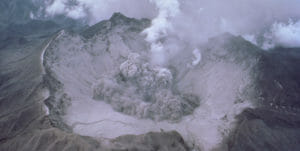Geoengineering Is Still Nowhere Close to Working
Humans cannot expect a safer, cooler world from technological fixes. The 1991 eruption of Mount Pinatubo in the Philippines cooled the planet by about 0.5°C (0.9 F) for two years. (ibrahim kusuma / Unsplash)
The 1991 eruption of Mount Pinatubo in the Philippines cooled the planet by about 0.5°C (0.9 F) for two years. (ibrahim kusuma / Unsplash)
Scientists have established a strategic error in one version of the climate change debate: they still say geoengineering is no guarantee of a cooler world.
There is no practical technology available to cool the Earth, they say – except the obvious one of ceasing to stoke the fires with fossil fuels.
One new study looks at all the tested and yet-to-be-explored mechanisms for either lowering global temperatures by reducing sunlight, or by harnessing new and old ways to capture the extra carbon dioxide released by two centuries of industrial growth.
And, the authors report, the sure way to reduce the dangers of global warming and keep the planetary temperature increase to 2°C (3.6 F) or lower by 2100 is to switch to wind and solar energy sources and drastically cut fossil fuel emissions.
A second, separate study looks closely at an often-proposed form of geoengineering – the injection of sulphate aerosols into the stratosphere to intercept sunlight and shade the planet – and delivers a cautious verdict.
Yes, it might reduce planetary surface warming. But the same technology could lead to continued ocean warming and ever-faster loss of the ice caps.
Geoengineering – the technological fix that would permit humans to go on burning coal, oil and natural gas – has been repeatedly dismissed as an answer by successive teams of researchers: either the outcome is uncertain, or the consequences potentially hazardous or politically dangerous.
European climate scientists report in the journal Nature Communications that they looked at the goals of the Paris Agreement – in which 195 nations in Paris in 2015 vowed to limit global warming to “well below” 2°C and if possible 1.5°C (2.7 F) above the average for most of recorded human history – and came to a simple answer: no proposed technological solution could make much difference to global warming, without also the impact of drastic cuts in greenhouse gas emissions.
Plans to sow the soil with biochar as a form of carbon storage were probably impractical on any scale. Massive planting of trees to draw down carbon from the atmosphere might not work as planned. The addition of nutrients to spur phytoplankton blooms in the oceans would disrupt natural nutrient cycles and might increase the emissions of another greenhouse gas, nitrous oxide. Plans to capture carbon directly from the air could be ferociously expensive – because humans released 40 billion tonnes of carbon dioxide from fossil fuels in 2017.
No Significant Contribution
“None of the proposed technologies can realistically be implemented on a global scale in the next few decades. In other words, we can’t rely on these technologies to make any significant contribution to holding the average temperature increase under the 2°C limit, much less the 1.5°C limit”, said Mark Lawrence, scientific director of the Institute for Advanced Sustainability Studies in Potsdam, Germany, who led the research.
And scientists at the US National Centre for Atmospheric Research in Boulder, Colorado took a close look at perhaps the most-studied and much-disputed proposal to engineer the climate: the injection of sulphate aerosols into the upper atmosphere to reduce incoming radiation.
This is in one sense nature’s way to cool down the planet a little: it happened, for instance, after the eruption of Mt Pinatubo in the Philippines in 1991 hurled enough ash into the stratosphere to lower planetary temperatures by 0.5°C for about two years.
And, the scientists report in Nature Geoscience, one version of the proposal could be made to work, and computer modelling predicted that it would minimise changes in the planetary surface temperature.
Seas to Rise
But it would also accelerate the Atlantic meridional overturning circulation – a powerful force at work in the ocean – and lead to continued warming of the deep, and of the polar oceans.
So the ice caps would go on melting, and sea levels would rise. There would be unpredictable changes in the Indian, South American and African rainy seasons and in hurricane activity.
“Considerable uncertainty therefore surrounds the potential impacts of such shifts, and the relative magnitude of such impacts to those where geoengineering is not implemented”, they write.
They say their study highlights the need to better understand the risks of such actions, along with the sheer complexity of the planetary climate machine and “the need to better develop our understanding of the climate system before the character of a geoengineered climate can be estimated with confidence.”
Your support matters…Independent journalism is under threat and overshadowed by heavily funded mainstream media.
You can help level the playing field. Become a member.
Your tax-deductible contribution keeps us digging beneath the headlines to give you thought-provoking, investigative reporting and analysis that unearths what's really happening- without compromise.
Give today to support our courageous, independent journalists.







You need to be a supporter to comment.
There are currently no responses to this article.
Be the first to respond.